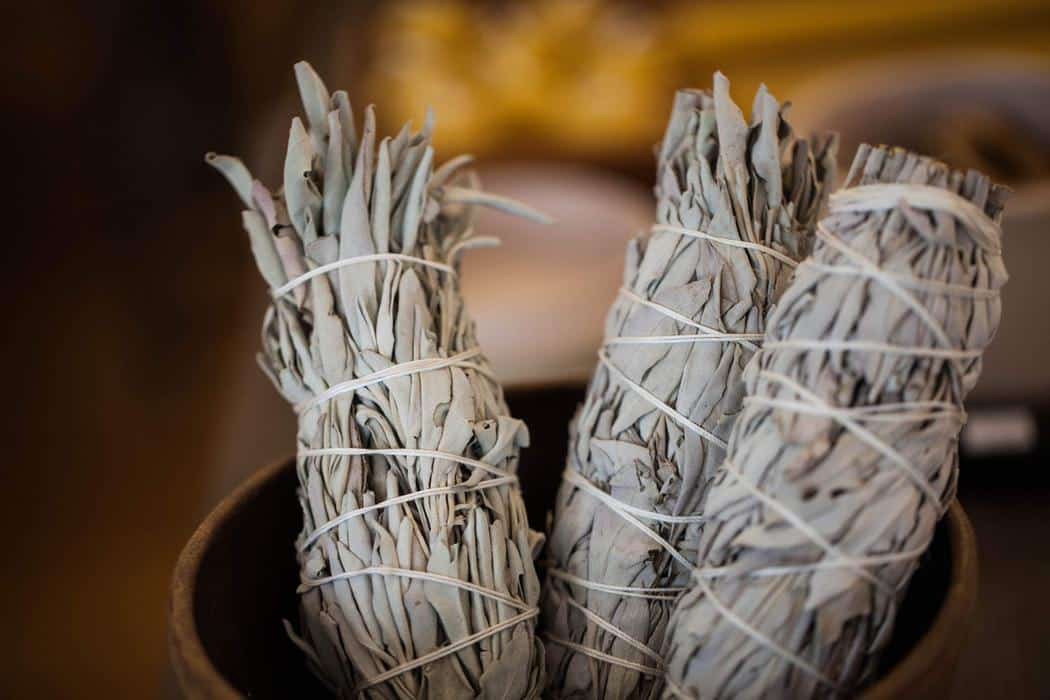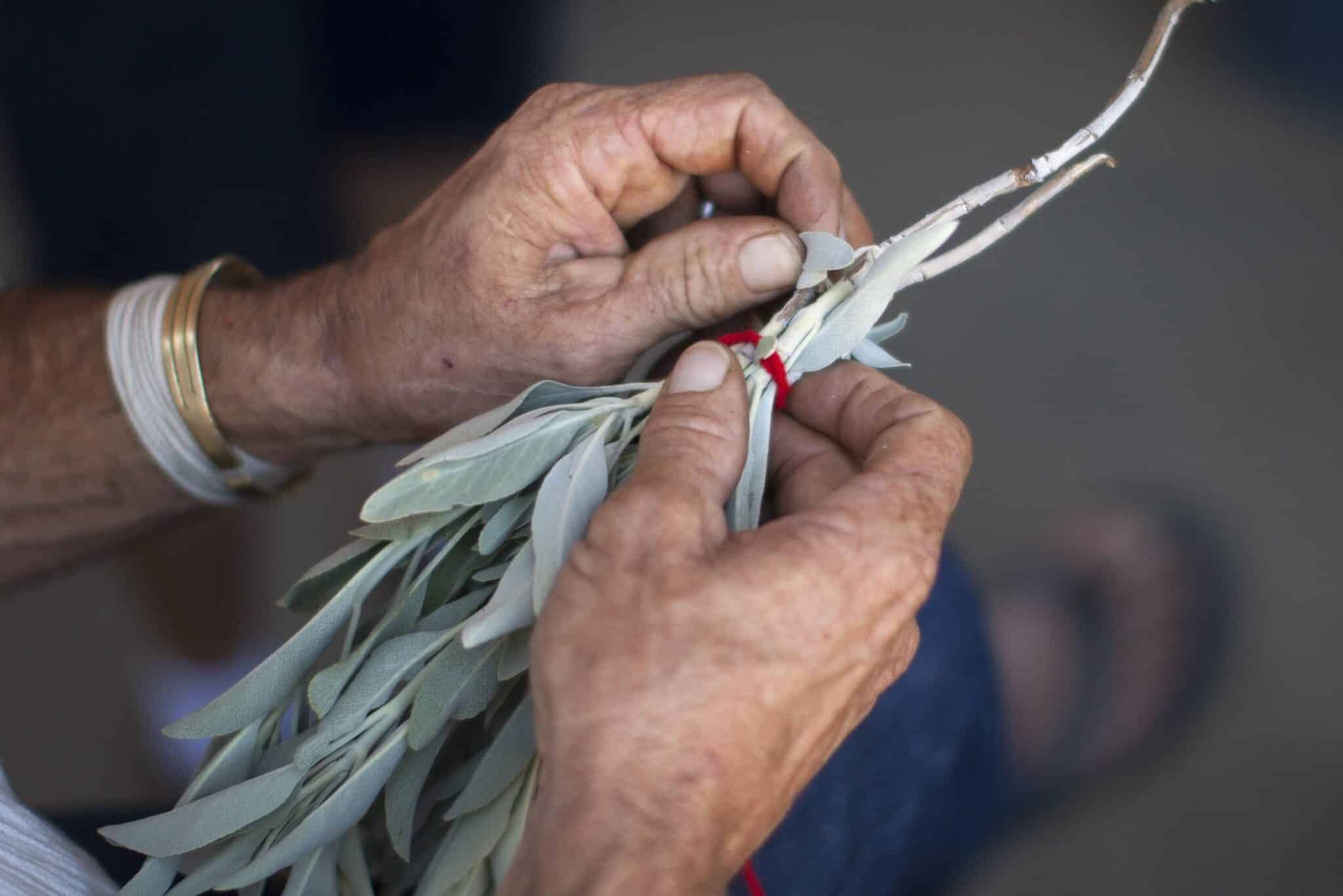

Ron Goodman and his boss were training a new volunteer ranger at the North Etiwanda Preserve, a lush and rocky landscape in the foothills of the Cucamonga Wilderness, roughly 50 miles east of Los Angeles. They were looking out over an area of burn scar when Goodman spotted three men with duffle bags among the sand-colored boulders. He knew exactly what they were doing and took off running in their direction.
It was the first time the ranger had intercepted illegally harvested white sage, but it wouldn’t be a unique experience.
“I cannot explain how difficult it is to march this stuff out. The bags can weigh 70 to 100 pounds. It’s rocky terrain and there’s no shade, we have rattlesnakes. And yet they still do it,” said Goodman, a retired San Bernardino County ranger.
Poaching white sage for commercial sale, mostly bundled in smudge sticks or distilled into essential oils, has threatened the plant’s survival in recent years. Police estimate the plant sells for around $30 per pound wholesale — and the industry is booming. But wild white sage has been disappearing in California for decades. Climate change, invasive species, unprecedented fires and sprawling development has chipped away at coastal sage scrub in Southern California, as well as the delicate web flora that grow alongside it, many of them rare, threatened or endangered. Salvia apiana itself is unlisted by the U.S. Fish and Wildlife Service, which keeps a database of threatened and endangered species.
The average processing time for the threatened and endangered species is 12 years, and plants usually take longer than animals. Despite official data regarding how much remains in the wild, the Indigenous people who have used white sage for centuries as well as the ecologists and rangers who work in the area understand that it’s disappearing.
“It doesn’t even grow around Los Angeles anymore,” said Goodman. “The plants are really suffering from the drought this year and because poaching has been going on for years, the plants haven’t been allowed to reach their full size. That’s in addition to what we’ve lost to development.”
Human Development and Climate Change
The natural territory of coastal sage scrub spans from Santa Barbara to El Rosario in northwestern Baja California, occasionally popping up in patches along the central California coast. In Southern California, the shrubland exists almost entirely in the wildland-urban interface, where housing developments carve into swaths of wild vegetation. Development has transformed the complex network of grasslands, thickets of dwarf evergreen shrubs and riparian corridors that once ruled the landscape. The World Wildlife Fund estimates that due to human land conversion, only about 15 percent of the California Coastal Sage and Chaparral ecoregion remains intact.
Nothing in an ecosystem exists in a vacuum. White sage is mycorrhizal, meaning its roots form vital relationships with beneficial fungi in soil. So when the plant disappears from its native community, the absence throws the ecosystem out of balance. This paves the way for invasive grasses like Bromus rubens and Avena barbata. “These grasses create a flash fuel problem that allows fires to very easily spread through the area,” said Arlee Montalvo, a retired senior plant restoration ecologist for the Riverside-Corona Resource Conservation District.
Nine of the 10 largest wildfires in California history have happened in the last nine years. All plants, including those in coastal sage scrub habitats, have adapted to regular bouts of fire. Some seeds even need the smoke to germinate. But flora today are faced with wildfires that burn at a temperature and with a frequency they haven’t evolved to withstand.
“In 2003, the human-caused Grand Prix burned with such intensity that the sage never came back,” said Goodman.
A Trend That’s Fueling Poaching
Like dietary supplements and medicinal herbs, the white sage market is almost completely unregulated. Consumers have no way of knowing what labels that dub products sustainably or ethically wildcrafted actually mean — and some argue harvesting sage for commercial use isn’t ethical at all.
Under California State law, no one is allowed to harvest white sage growing on public land for commercial sale. Harvesting on private land is legal with written permission from the land owner, though Goodman said that is a rare occurrence.
“A lot of vendors say their product is sustainably sourced from the hills of California. Unless they can say exactly where it’s grown, we can be pretty sure it’s stolen,” said Rose Ramirez, an ethnobotanist who lives in San Diego County and who is of Chumash and Yaqui descent.
In 2018, the Rancho Cucamonga Police Department made their largest bust to date. Four people had stuffed 400 pounds of poached white sage into backpacks they’d plan to hike out of a valley in the North Etiwanda Preserve.
The following year, the department arrested 24 people for poaching white sage, police records show. According to Goodman, deputies have used helicopters, infrared cameras and a bloodhound to surveil the area in the past, but a dwindling budget means just a few rangers are charged with patrolling the 1,200-acre area.
Susan Leopold, director of United Plant Savers, a non-profit dedicated to protecting native medicinal plants in the U.S. and Canada, calls the North Etiwanda Preserve the “mecca of the white sage mafia.”
“The North Etiwanda Preserve is very unique, ecologically speaking, and white sage grows in big, lush clusters that don’t appear anywhere else in California. It’s easy to pick a lot quickly in the preserve,” said Leopold. (Under state law, white sage in this specific area is protected under the California Endangered Species Act.)
Goodman and a group of 12 core volunteers at the Cucamonga Foothills Preservation Alliance patrol the foothills of the preserve, educating their neighbors on what to look out for and reporting suspected poachers to local law enforcement. The alliance has aided in the confiscation of 200 pounds of sage seeds and thousands of pounds of harvested white sage.
“When we encounter the poachers, they act on it. Three years ago, they weren’t,” said Goodman. “But law enforcement is now behind getting white sage more protection. They now understand the cultural and ecological significance.”
Pushing for Transparency
A man bundles white sage, which is burned as an incense in blessings and sacred ceremonies, at the annual traditional agave roast at the Malki Museum on the Morongo Indian Reservation near Banning, California, April 11, 2015. DAVID MCNEW / AFP / Getty Images
Burning white sage is cultural appropriation for anyone who is not part of a culture that traditionally uses the sacred plant in ceremony. American Indian/Alaska Native people were subject for nearly a century to Eurocentric laws that jailed or even killed them for practicing their religions, including burning white sage. For these reasons, Native communities have been calling on non-Native people who burn sage to stop. While some argue that cultural appropriation should be reason enough to stop masses of non-AIAN people from using white sage, others see the commercial sale of white sage as something that is here to stay.
Ramirez is part of a group that’s trying to get white sage recognized as a culturally significant plant at the state level, which could pave the way for it to eventually be recognized as threatened or endangered. This could save some white sage habitat from development. She’s also among those who see working to make the industry more sustainable as the most realistic option to protect wild white sage, which can be legally harvested by local tribes for personal use.
“We are way beyond this idea of not selling white sage. It’s being sold all over the world, by places like Wal-Mart and Alibaba,” Ramirez told EcoWatch, noting that some wholesale listings are specifically marketed towards yoga studios.
While Ramirez and fellow ethnobotanist Deborah Small don’t encourage non-Native people to use white sage, they recognize that it’s now deeply rooted in pop culture, largely thanks to social media. In that case, they want people to grow white sage if they can, especially if they live in places like Orange County and Riverside, California, where the wild population has been decimated by construction. “We want people to concentrate on rehabilitating white sage in areas where it used to grow,” said Ramirez.
The second option, they say, is to only purchase products made from farmed plants, rather than those that claim to be wildcrafted or foraged. The team is currently working on creating a white sage verification system that would force the industry to be transparent about where they source their product.
“Foragers or wildcrafters think it’s their right and they make it seem so innocent. It wouldn’t be such a bad thing if we didn’t also have the climate change, the over development; if we had massive amounts of this plant left,” said Ramirez.
Kaitlin Sullivan covers the environment, science and health beats. Her work has appeared in NBC News, Popular Science, NPR, VICE and Inverse, among others. Before becoming a journalist, she worked on a farm in Western Colorado, at a hostel in Brazil and as an editor for the American Alpine Club.
Follow her on Twitter: @kaitsulliva

 233k
233k  41k
41k  Subscribe
Subscribe 
